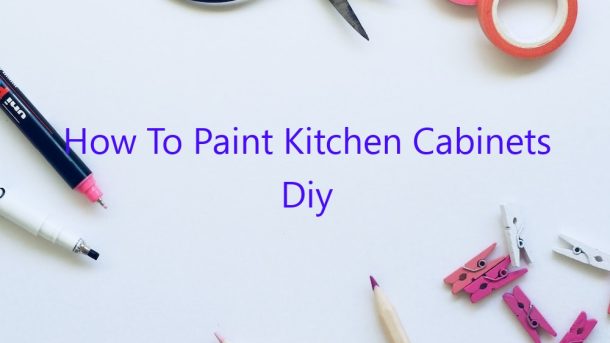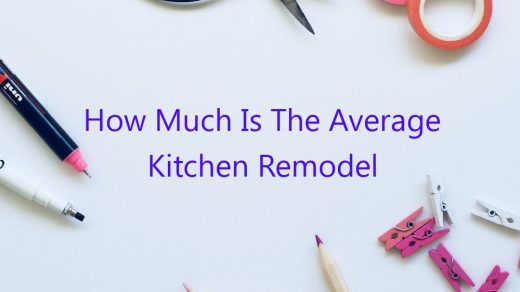If you’re looking to update your kitchen on a budget, painting your kitchen cabinets is a great way to do it! Painting your cabinets can completely change the look of your kitchen, and it’s a project that you can do yourself with a little bit of preparation and some basic painting skills.
The first step in painting your kitchen cabinets is to remove all of the cabinet hardware, including the knobs, pulls, and hinges. Once the hardware is removed, you’ll need to sand down the surfaces of the cabinets to create a smooth surface for the paint to adhere to.
Once the cabinets are sanded, you can begin to paint them. Be sure to use a high-quality paint specifically designed for cabinets, and use a roller or a brush to apply the paint. Start by painting the inside of the cabinets, and then paint the outside. Once the paint is dry, reinstall the cabinet hardware.
It’s important to be patient when painting kitchen cabinets, as it can take a few coats of paint to achieve a smooth and even finish. Be sure to allow the paint to dry completely between coats.
If you’re looking to give your kitchen a fresh new look, painting your kitchen cabinets is a great way to do it! By following these simple steps, you can have beautiful new cabinets in no time!
Contents
Can I paint my kitchen cabinets on my own?
Can I paint my kitchen cabinets on my own?
Yes, you can paint your kitchen cabinets on your own, but it is a time-consuming and labor-intensive project. Before you begin, make sure you have all the supplies you need and the space to work in.
To paint kitchen cabinets, you will need:
– A paintbrush
– A roller
– A paint tray
– A ladder
– A drill
– A screwdriver
– Sandpaper
– Primer
– Paint
First, remove the cabinet doors and drawers and sand them down to remove any old paint or sealant. Then, drill holes in the cabinet frames to attach the hinges. Once the hinges are in place, reattach the doors and drawers.
Next, apply a coat of primer to the cabinets and let it dry. Once the primer is dry, apply a coat of paint. Be sure to use a brush for the crevices and a roller for the flat surfaces. Let the paint dry and then apply a second coat.
Finally, reattach the hardware and stand back to admire your work!
What kind of paint do you use on kitchen cabinets?
What kind of paint should you use on kitchen cabinets?
The type of paint you should use on kitchen cabinets largely depends on the material of the cabinet. If your cabinets are made of wood, you can use a variety of paints, such as enamel paint, latex paint, or oil-based paint. Enamel paint is a good choice for cabinets because it is durable and can be cleaned easily. Latex paint is also a good choice for cabinets, as it is durable and easy to clean. However, latex paint may not be the best choice if your cabinets are made of a porous material, such as wood, as it may not be as durable as enamel paint. Oil-based paint is a good choice for cabinets that are made of a porous material, as it is more durable than latex paint. However, oil-based paint is also more difficult to clean than latex paint.
If your cabinets are made of a non-porous material, such as metal or plastic, you can use a variety of paints, such as enamel paint, latex paint, or spray paint. Enamel paint is a good choice for cabinets that are made of a non-porous material, as it is durable and can be cleaned easily. Latex paint is also a good choice for cabinets that are made of a non-porous material, as it is durable and easy to clean. However, latex paint may not be the best choice if your cabinets are made of a porous material, such as wood, as it may not be as durable as enamel paint.
Is it better to roll on or brush on paint kitchen cabinets?
When it comes to painting your kitchen cabinets, there are two main ways to do it: rolling on the paint or brushing it on. Both methods have their own advantages and disadvantages, so it can be difficult to decide which one is the best option for you. In this article, we’ll take a look at the pros and cons of each method, so you can make an informed decision about which one is right for you.
Rolling on paint is a fairly simple process. You just need to pour the paint into a paint tray, dip the roller into the paint, and then roll it on the cabinets. This method is ideal for beginners, as it is easy to control and the results are very even. However, it can be a bit messy and it can be difficult to get into tight spaces.
Brushing on paint is a bit more complicated, but it results in a more polished finish. You need to mix the paint with a brush cleaner to create a smooth, even coating. This method is ideal for cabinets with lots of details or curves, as it is easy to get into tight spaces. However, it can be difficult to control the amount of paint that is applied, and it can be easy to make mistakes.
Do you have to sand kitchen cabinets before painting?
Do you have to sand kitchen cabinets before painting them? The answer to this question depends on the type of paint you plan to use.
If you’re using a latex paint, you don’t have to sand your cabinets before painting them. However, if you’re using an oil-based paint, you should sand your cabinets to create a smooth surface for the paint to adhere to.
If you’re using a primer, you should also sand your cabinets before painting them. This is because a primer helps to create a smooth surface for the paint to adhere to.
If you’re using a paint sprayer, you should also sand your cabinets before painting them. This is because a paint sprayer helps to create a smooth surface for the paint to adhere to.
What is the easiest way to paint cabinets?
There are many ways to paint cabinets, but some are definitely easier than others. The easiest way to paint cabinets is to use a spray paint. This is because the paint will go on evenly and will be less likely to streak.
To use spray paint, you will need to first clean and sand the cabinets. Then, you will need to apply a primer to the cabinets. Once the primer is dry, you can apply the spray paint. Be sure to follow the instructions on the can, and allow the paint to dry completely before you use the cabinets.
If you do not want to use spray paint, you can also use a brush. However, this will be more time consuming and may not give you as even of a coat.
Whichever method you choose, be sure to allow for adequate drying time between coats. This will ensure that the cabinets are fully covered and will not chip or peel.
Do you have to Prime cabinets before painting?
If you’re wondering if you need to prime your cabinets before painting them, the answer is: it depends. In some cases, priming is necessary in order to achieve a smooth, even finish. However, in other cases, you may be able to get away with skipping the primer and still achieve a great paint job.
If your cabinets are in good condition and you’re planning to use a latex paint, you may be able to get away with just a light sanding and a coat of paint. However, if your cabinets are made from a porous material (like wood), or if they have any existing stains or blemishes, you’ll need to prime them before painting.
There are a few different types of primer available, so it’s important to choose one that’s specifically designed for cabinets. You can find primers that are made to seal in stains, cover up old paint colors, or create a smooth surface for painting.
If you’re not sure whether or not you need to prime your cabinets, it’s always best to err on the side of caution and do it anyway. Priming is a relatively quick and easy process, and it will help ensure that your paint job looks great and lasts for years.
Do I need to prime cabinets before painting?
Cabinets are a key focal point in any kitchen or bathroom. They make a statement, and can really be the centerpiece of the room. Because of this, it’s important to make sure they’re in good condition before you start painting them.
One question that often comes up is whether or not you need to prime cabinets before painting them. The answer is – it depends. If your cabinets are in good condition and have a smooth surface, you may not need to prime them. However, if your cabinets are older or have any dings or scratches, priming them will help the paint to adhere better and will result in a longer-lasting finish.
If you decide to prime your cabinets, be sure to use a good-quality primer that will cover any existing paint or stains. After the primer has dried, you can then start painting your cabinets using the color of your choice.
Taking the time to properly prepare your cabinets before painting them will ensure that you end up with a beautiful, long-lasting finish.




